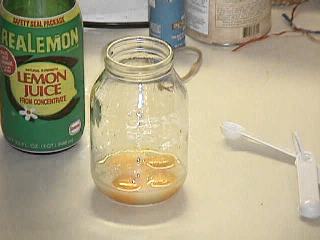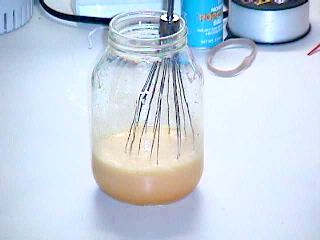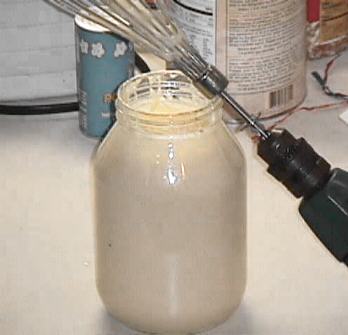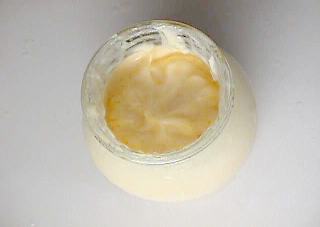Converting Eggs Into
Mayonnaise
by Dennis
Hawkins
When you have a surplus of eggs, it is handy
to know a few kitchen tricks to use them to make practical things. The obvious
things are eggnog, custard, and deviled eggs. One less obvious egg product
is mayonnaise. The only problem with making mayonnaise is that if you don't
know it's secret, you will always end up with a gooey mess rather than actual
mayonnaise. The ingredients to mayonnaise are as follows:
4 Jumbo Egg Yolks (separate and discard the
whites)
6 Teaspoons (Real Lemon Brand) Lemon Juice
3 cups soybean oil (sold as "vegetable" oil)
2 Teaspoons Onion Powder
1 Teaspoon Salt
1 Teaspoon Sugar or 1/2 packet of Splenda Brand (sucralose artificial
sweetener)
If you threw all of these into a blender you
would not get mayonnaise. You would get a slimy mess instead. This is because
there is a trick to making real mayonnaise.
Before attempting to make mayonnaise, it is
important to understand how mayonnaise works. To do that, a little background
in food chemistry is needed. Mayonnaise is an emulsion of vegetable oil in
lemon juice stabilized by the molecule lecithin, found in egg yolks. Mayonnaise
does not taste all that oily even though most of it is oil. This is because
every molecule of oil is surrounded by a microscopic amount of lemon juice.
Thus, it is important to remember that mayonnaise is not a small amount of
lemon juice blended into oil, but is instead, a large amount of oil blended
into a tiny amount of lemon juice.
The key to making mayonnaise is to avoid having
the components of the emulsion separate back into the components. In cooking,
this is called breaking. No matter how much you mix the oil and lemon
juice together, it will always separate (break) into a gooey mess unless
you include the egg yolk as a stabilizer. The lecithin in the egg yolk acts
like detergent in dissolving both the oil and the lemon juice components.
This is what keeps mayonnaise fluffy.
 Now that you
understand the chemistry behind making mayonnaise, lets begin. First, separate
the yolks from four jumbo eggs and place it in a quart jar with the lemon
juice. The whites from the egg should be discarded. If you try to include
them, the recipe will not work. The photo on the right shows this.
Now that you
understand the chemistry behind making mayonnaise, lets begin. First, separate
the yolks from four jumbo eggs and place it in a quart jar with the lemon
juice. The whites from the egg should be discarded. If you try to include
them, the recipe will not work. The photo on the right shows this.
The ratio of lemon juice to the oil has to be
exact so it is best to use measuring spoons and not guess. Note that in the
ingredient list I specified to use a brand name lemon juice. You may be tempted
to go out and grab a lemon off the tree, but you should know that natural
lemons are not consistent in their concentration. As such, a natural lemon
may be too strong or too weak. Store bought lemon juice is what this recipe
requires.
 The
next thing to do is to mix the yolk and juice together using a high speed
mixer with a wire wisp until the mixture is frothy. Since I didn't have a
high speed mixer, I improvised by attaching a wire wisp to an electric drill.
The speed of the drill needs to be set to medium to fast which is about
perfect for making mayonnaise. When mixing, you need three hands if you use a
hand drill. If you are doing this alone, a drill press fitted with a wire wisp
is very handy. Ordinary
electric mixer blades may not produce acceptable results. You may be tempted
to use a blender, but if you do, you will get a mess instead of mayonnaise.
Whatever type of mixer you use, it must mix the full column of mayonnaise
at the same time (as in the case of a wire wisp). Most blenders have only
a small impeller at the bottom so they wont work for making mayonnaise.
The
next thing to do is to mix the yolk and juice together using a high speed
mixer with a wire wisp until the mixture is frothy. Since I didn't have a
high speed mixer, I improvised by attaching a wire wisp to an electric drill.
The speed of the drill needs to be set to medium to fast which is about
perfect for making mayonnaise. When mixing, you need three hands if you use a
hand drill. If you are doing this alone, a drill press fitted with a wire wisp
is very handy. Ordinary
electric mixer blades may not produce acceptable results. You may be tempted
to use a blender, but if you do, you will get a mess instead of mayonnaise.
Whatever type of mixer you use, it must mix the full column of mayonnaise
at the same time (as in the case of a wire wisp). Most blenders have only
a small impeller at the bottom so they wont work for making mayonnaise.
Let the egg yolk mixture sit for 3-5 minutes.
There is always a danger in using raw eggs in any recipe, but letting this
mixture sit for a few minutes allows the lemon juice to "pickle" any germs
that might have been in the eggs. The risk of getting food poisoning from
a raw egg is extremely low, but letting the lemon juice 'cook' it for a few
minutes will make it even less of a risk.
Next, start the wisp spinning at maximum speed
and S-L-O-W-L-Y dribble in the oil. Remember that you are mixing a large
amount of oil into a very small amount of lemon juice. This takes a lot of
time. You should not try to pour the oil in faster than about 1/2 teaspoonful
per second. As you do this, it is very helpful to have a kitchen helper hold
the quart jar for you or use a drill press if you are working alone. Once all the oil is in, blend a few seconds longer
just to make sure any oil on the sides of the jar gets included in the emulsion.
 Mix in the
remaining ingredients. These are just for flavor and do not affect the mayonnaise
consistency. Try not to be tempted to use real onions instead of onion powder.
Doing so may cause the mayonnaise to break (turn to goo). You should not
add any other liquid to the emulsion at this time. A lot of people make the
mistake of adding the egg whites back in at this point, but this always results
in a slimy goo rather than mayonnaise. It is really rather depressing to
see this happen after you actually made the mayonnaise. When you are done,
stop the drill and remove the wisp. The mayonnaise should be thick and able
to stand up on its own. It should not be runny at all. You should be able
to turn the jar on its side without the mayonnaise running out.
Mix in the
remaining ingredients. These are just for flavor and do not affect the mayonnaise
consistency. Try not to be tempted to use real onions instead of onion powder.
Doing so may cause the mayonnaise to break (turn to goo). You should not
add any other liquid to the emulsion at this time. A lot of people make the
mistake of adding the egg whites back in at this point, but this always results
in a slimy goo rather than mayonnaise. It is really rather depressing to
see this happen after you actually made the mayonnaise. When you are done,
stop the drill and remove the wisp. The mayonnaise should be thick and able
to stand up on its own. It should not be runny at all. You should be able
to turn the jar on its side without the mayonnaise running out.
 When
you have completed, your mayonnaise should look like the mayonnaise in the
photo to the left. If yours came out too runny, throw it out and try again.
Unlike many other recipes, the recipe for mayonnaise must be followed to
the letter. Good luck and remember to keep your mayonnaise refrigerated.
When
you have completed, your mayonnaise should look like the mayonnaise in the
photo to the left. If yours came out too runny, throw it out and try again.
Unlike many other recipes, the recipe for mayonnaise must be followed to
the letter. Good luck and remember to keep your mayonnaise refrigerated.
Back to the Egg Recipes
Page
Back to the PBCPFA
Main Page
 Now that you
understand the chemistry behind making mayonnaise, lets begin. First, separate
the yolks from four jumbo eggs and place it in a quart jar with the lemon
juice. The whites from the egg should be discarded. If you try to include
them, the recipe will not work. The photo on the right shows this.
Now that you
understand the chemistry behind making mayonnaise, lets begin. First, separate
the yolks from four jumbo eggs and place it in a quart jar with the lemon
juice. The whites from the egg should be discarded. If you try to include
them, the recipe will not work. The photo on the right shows this.
 The
next thing to do is to mix the yolk and juice together using a high speed
mixer with a wire wisp until the mixture is frothy. Since I didn't have a
high speed mixer, I improvised by attaching a wire wisp to an electric drill.
The speed of the drill needs to be set to medium to fast which is about
perfect for making mayonnaise. When mixing, you need three hands if you use a
hand drill. If you are doing this alone, a drill press fitted with a wire wisp
is very handy. Ordinary
electric mixer blades may not produce acceptable results. You may be tempted
to use a blender, but if you do, you will get a mess instead of mayonnaise.
Whatever type of mixer you use, it must mix the full column of mayonnaise
at the same time (as in the case of a wire wisp). Most blenders have only
a small impeller at the bottom so they wont work for making mayonnaise.
The
next thing to do is to mix the yolk and juice together using a high speed
mixer with a wire wisp until the mixture is frothy. Since I didn't have a
high speed mixer, I improvised by attaching a wire wisp to an electric drill.
The speed of the drill needs to be set to medium to fast which is about
perfect for making mayonnaise. When mixing, you need three hands if you use a
hand drill. If you are doing this alone, a drill press fitted with a wire wisp
is very handy. Ordinary
electric mixer blades may not produce acceptable results. You may be tempted
to use a blender, but if you do, you will get a mess instead of mayonnaise.
Whatever type of mixer you use, it must mix the full column of mayonnaise
at the same time (as in the case of a wire wisp). Most blenders have only
a small impeller at the bottom so they wont work for making mayonnaise.
 Mix in the
remaining ingredients. These are just for flavor and do not affect the mayonnaise
consistency. Try not to be tempted to use real onions instead of onion powder.
Doing so may cause the mayonnaise to break (turn to goo). You should not
add any other liquid to the emulsion at this time. A lot of people make the
mistake of adding the egg whites back in at this point, but this always results
in a slimy goo rather than mayonnaise. It is really rather depressing to
see this happen after you actually made the mayonnaise. When you are done,
stop the drill and remove the wisp. The mayonnaise should be thick and able
to stand up on its own. It should not be runny at all. You should be able
to turn the jar on its side without the mayonnaise running out.
Mix in the
remaining ingredients. These are just for flavor and do not affect the mayonnaise
consistency. Try not to be tempted to use real onions instead of onion powder.
Doing so may cause the mayonnaise to break (turn to goo). You should not
add any other liquid to the emulsion at this time. A lot of people make the
mistake of adding the egg whites back in at this point, but this always results
in a slimy goo rather than mayonnaise. It is really rather depressing to
see this happen after you actually made the mayonnaise. When you are done,
stop the drill and remove the wisp. The mayonnaise should be thick and able
to stand up on its own. It should not be runny at all. You should be able
to turn the jar on its side without the mayonnaise running out.
 When
you have completed, your mayonnaise should look like the mayonnaise in the
photo to the left. If yours came out too runny, throw it out and try again.
Unlike many other recipes, the recipe for mayonnaise must be followed to
the letter. Good luck and remember to keep your mayonnaise refrigerated.
When
you have completed, your mayonnaise should look like the mayonnaise in the
photo to the left. If yours came out too runny, throw it out and try again.
Unlike many other recipes, the recipe for mayonnaise must be followed to
the letter. Good luck and remember to keep your mayonnaise refrigerated.